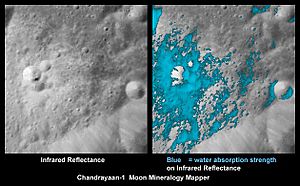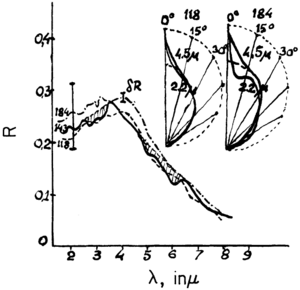Lunar water facts for kids

Lunar water is simply water found on the Moon. Scientists have discovered water molecules on the Moon's sunlit surface. However, sunlight slowly breaks down this water into hydrogen and oxygen, which then escape into space.
But there's good news! Scientists have also found water ice in very cold, dark areas at the Moon's poles. These spots are called permanently shadowed craters because sunlight never reaches them. There are also tiny amounts of water molecules in the Moon's super thin atmosphere.
Water (H2O) and a related chemical group called hydroxyl (-OH) are often found chemically stuck to lunar minerals. This means they are not free-flowing water. Scientists believe that most of the Moon's surface has these forms of water in small amounts. For example, some estimates suggest there are about 10 to 1000 parts per million of water "stuck" to the surface material.
Scientists have been looking for water on the Moon for a long time. In 1976, the Soviet Luna 24 probe landed on the Moon. It collected samples from different depths of the lunar soil, called regolith, and brought them back to Earth. In 1978, tests showed these samples contained about 0.1% water by weight.
More recently, in 2009, NASA's Moon Mineralogy Mapper (M3) on India's Chandrayaan-1 probe found signs of water on the Moon's surface. An Indian probe called the Moon Impact Probe, also from Chandrayaan-1, crashed into a crater and helped confirm water ice was there. In 2018, NASA confirmed that M3 showed water ice at the Moon's poles. Then, in 2020, NASA confirmed water on the sunlit parts of the Moon too!
So, where does this water come from? It might have arrived on the Moon over billions of years from comets, asteroids, and meteoroids crashing into it. Another idea is that it's made right on the Moon. This happens when hydrogen particles from the solar wind hit oxygen atoms in lunar rocks.
Finding water on the Moon is a big deal! It could make it much easier and cheaper for humans to live on the Moon in the future.
Contents
How Water Might Form and Stay on the Moon
Making Water on the Moon
Lunar water can come from two main places:
- Space objects: Water-rich comets and other space rocks hitting the Moon.
- Made on the Moon: This happens when hydrogen particles (called protons) from the solar wind react with oxygen atoms in lunar minerals. This reaction can create small amounts of water or hydroxyl groups. These are then trapped inside the minerals.
Imagine oxygen atoms on the surface of a rock. When hydrogen particles from the Sun hit them, they can combine to form hydroxyl groups (X–OH). Then, two hydroxyl groups can combine to make a water molecule (H2O). This water molecule might then stick to the mineral's surface.
Trapping Water on the Moon
Normally, solar radiation would quickly break down any free water or ice on the Moon. It would split into hydrogen and oxygen, which would then float away into space.
However, the Moon's tilt is very slight. This means some deep craters near the poles never get any sunlight. They are always in shadow. The temperature in these dark craters stays super cold, around -170 degrees Celsius. Any water that ends up in these craters can stay frozen and stable for billions of years.
These ice deposits might be thick, but they are probably mixed in with the lunar soil. They might even be in layers.
Moving Water Around
Even though free water can't last long in sunny areas, water made there might move. It could evaporate and then condense in the super cold polar areas. This would add to any ice brought by comets.
Scientists are still trying to figure out exactly how water moves and gets trapped. Water made in sunny, hot areas might not last long enough to travel far. So, water molecules made close to a cold, dark polar crater would have the best chance of surviving and getting trapped.
Liquid Water Deep Inside the Moon
Billions of years ago, the Moon might have had enough atmosphere and even liquid water on its surface. Today, warm and pressurized areas deep inside the Moon might still hold liquid water.
Why Lunar Water is Important
Having lots of water on the Moon would be a huge help for future Moon bases. Carrying water (or hydrogen and oxygen) from Earth is extremely expensive.
If we find large amounts of water ice, we could mine it. This ice could provide drinking water for astronauts and water for growing plants. We could also use solar power or a nuclear generator to split the water into hydrogen and oxygen. Oxygen would be used for breathing, and both hydrogen and oxygen are parts of rocket fuel. The hydrogen from the water could also help extract more oxygen from the lunar soil.
Studying lunar ice would also give us important scientific clues. It could tell us about how many comets and asteroids hit the Moon in the early Inner Solar System. This helps us understand the history of our solar system.
Who Owns Lunar Water?
If we find a lot of usable water on the Moon, it brings up legal questions. Who owns this water? Who has the right to use it?
The United Nations Outer Space Treaty says that no country can claim ownership of the Moon itself. It also generally means countries can't claim ownership of lunar resources. However, most legal experts agree that how this plays out will depend on what countries or private companies actually do.
Another treaty, the Moon Treaty, says that using lunar resources should be managed by an "international system." But only a few countries have signed this treaty, mostly those without their own space programs.
Some countries, like Luxembourg and the US, have passed laws allowing their citizens to mine and own space resources, including those on the Moon. For example, US President Donald Trump stated this in an Executive Order in 2020.
See also
 In Spanish: Agua lunar para niños
In Spanish: Agua lunar para niños
- Water on Mars
- Chandrayaan-2 lunar orbiter and rover


